Midtown St. Louis is three miles west of the St. Louis, Missouri riverfront at the crossroads of Grand Boulevard and Lindell Boulevard. It includes the campus of Saint Louis University and the Grand Center arts district.
Historic status
The Midtown Historic District of St. Louis was placed on the National Register of Historic Places by the National Park Service, United States Department of the Interior in 1979.
Architecture
A remarkable collection of eclectic structures built between 1874 and 1930 range from Midtown's oldest building, a classic Second Empire style townhouse at 3534 Washington Ave. built during the first phase of Midtown development to flamboyant early Twentieth Century commercial buildings like the Art Deco Continental-Life Building, 3615 Olive Street and the "Siamese Byzantine" Fox Theatre, 527 N. Grand Blvd. Buildings in the district were designed by notable architects including Henry Hobson Richardson, Eames and Young, William B. Ittner, Preston J. Bradshaw, C. Howard Crane, Brad Cloepfil and Tadao Ando. From a distance the Midtown skyline asserts a strong node like St. Louis's "second downtown". Most of Midtown’s surviving historic structures have been restored and adapted for new uses.
Adaptive reuse of historic structures
A once dilapidated movie palace, Powell Hall, 718 N. Grand Blvd. is the sumptuous, Neo-classical acoustically vibrant home of the St. Louis Symphony and another is a thriving live performance venue, (the Fox Theatre). Buildings designed for worship are performing arts centers (Sheldon Concert Hall and the Grandel Theatre). The Continental-Life Building and the University Club Building that originally housed offices are now apartment buildings. Single family residences have been converted into elegant professional offices (City House in Grand Center, 3534 Washington Ave. and the Lionberger House, 3630 Grandel Square). Former clubhouse buildings serve as art centers: The St. Louis Club Building, 3663 Lindell Blvd., is now the Saint Louis University Museum of Art and The Knights of Columbus Building, 3547 Olive Street, is the Centene Center for the Arts, housing the St. Louis Arts and Education Council and numerous arts agencies.
New construction
As Midtown revived, new art museums (Contemporary Art Museum Saint Louis, 3750 Washington Ave. and the Pulitzer Foundation for the Arts, 3716 Washington Ave.) were built and the 1998 Dana Brown Communications Center, home of KETC, 3655 Olive Street, has become a focal point for public broadcasting and new media.
History
The only American Civil War battle in St. Louis, the Camp Jackson Affair, took place on May 10, 1861 when Union military forces clashed with civilians after capturing the Confederate Missouri Volunteer Militia commanded by General Daniel M. Frost. The Militia had been dispatched to St. Louis by Missouri Governor Claiborne Fox Jackson to seize the St. Louis Arsenal, and secure 40,000 rifles and muskets for the Confederacy. It camped outside St. Louis at Lindell's Grove which was renamed "Camp Jackson" by the militiamen. The site of Camp Jackson is on the campus of St. Louis University commemorated by a historical marker near the university's Busch Student Center. United States (Union) Army Captain, later General, Nathaniel Lyon marched from the Arsenal on the St. Louis riverfront to the rural site of Camp Jackson with a mixed force of 6,000 Regular Army troops and Home Guard volunteers. Frost surrendered to Lyon without a fight. However, after capturing Camp Jackson, Union Forces clashed with civilian bystanders resulting in the deaths of at least 28 people including Captain Constantin Blandowski, the first Union officer killed in the Civil War.[2]
Residential and commercial development of Midtown followed the Civil War as St. Louis expanded west in the 1870s. By the 1920s Midtown was a bustling district akin to New York City’s Times Square. Midtown deteriorated rapidly after World War II. However, in the 1970s, Father Paul C. Reinert, President of Saint Louis University inspired the urban renewal effort to rehabilitate the neighborhood and make use of its surviving buildings that continues in the Twenty First Century.
Demographics
In 2010 Midtown's racial makeup was 61.9% White, 25.8% Black, 0.2% American Indian, 9.2% Asian, 2.0% Two or More Races, and 0.9% Some Other Race. 2.8% of the people were of Hispanic or Latino origin.[3]
Gallery
| The Pulitzer Foundation for the Arts 2001 |
| Powell Symphony Hall 1925 |
| City House in Grand Center, Second Empire townhouse 1874 |
| Third Baptist Church 1885 with later renovations |
|
See also
References
- ↑ Census Summary By Neighborhoods
- ↑ Although usually described as "German", Captain Blandowski was ethnically Polish, born in Upper Silesia, on the German side of the Russo-German frontier. He received his military training in Germany, served with the French Foreign Legion, and fought for the Hungarian rebels in the failed Revolution of 1848. After emigrating to the U.S. was active in the Turnverein movement in St. Louis. Despite his Polish ethnicity, he was embraced by the German-American community as a martyr and a symbol of ethnic-German devotion to the Union. Burton, William L, Melting Pot Soldiers, Fordham University Press, Fordham, NY, 1998, p 41, ISBN 0-8232-1828-7
- ↑ http://dynamic.stlouis-mo.gov/census/neigh_comp.cfm
External links
Coordinates: 38°38′08″N 90°13′43″W / 38.6356°N 90.2287°W / 38.6356; -90.2287












